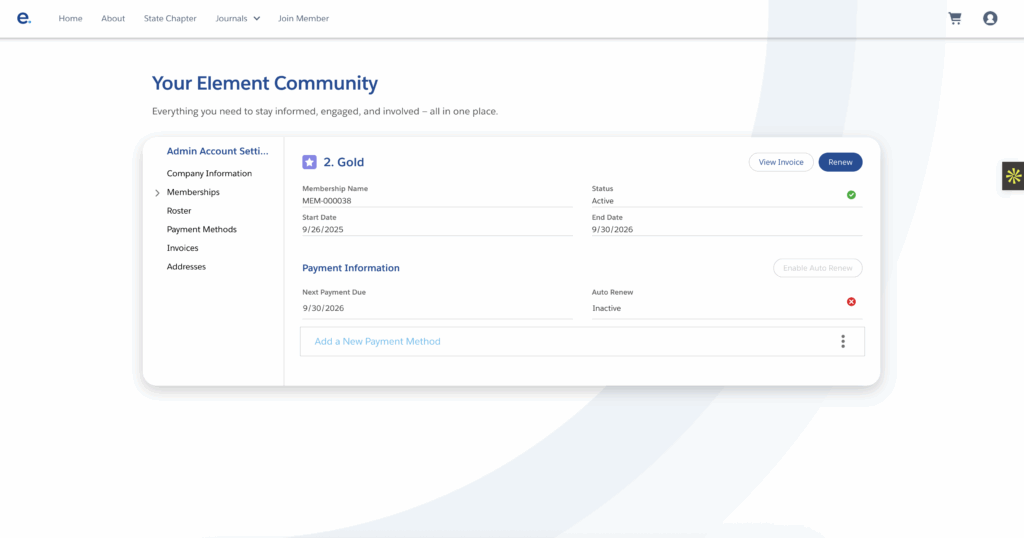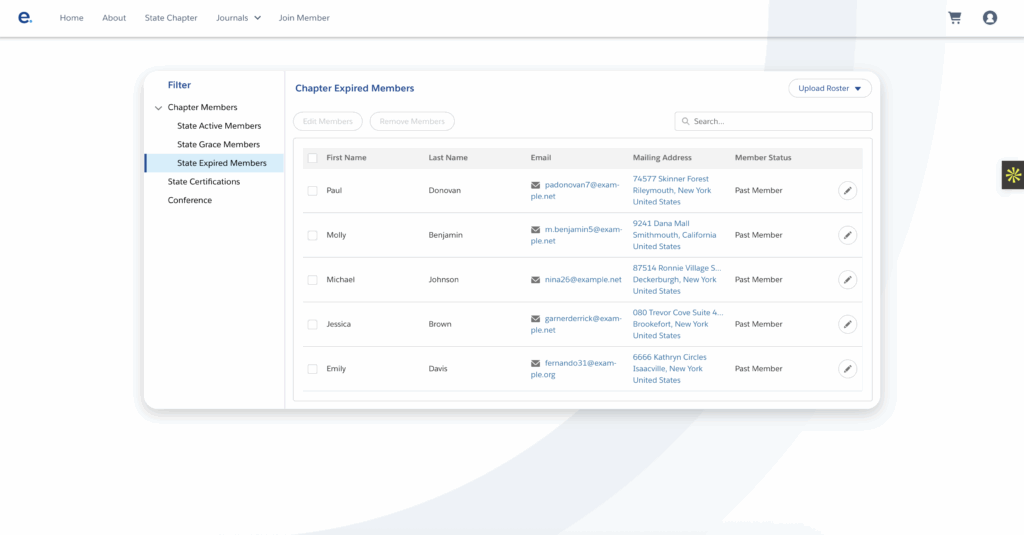All Blogs » Advanced Segmentation in Element AMS: Chapter Management, Reports & Retention Plays
Advanced Segmentation in Element AMS: Chapter Management, Reports & Retention Plays

What Key Metrics Matter Most to Associations?
This guide is for membership directors, community managers, volunteer and chapter managers, committee leads, Salesforce system/database admins, and association selection consultants. It shows how to use advanced segmentation in Element AMS to clean up data, delegate work, run sharp reports, and increase member retention.
Why Segmentation Matters
Segmentation groups members so you can act fast and with less guesswork. With Element AMS, a Salesforce-native association management system, segments are linked to memberships, events, and purchases. That makes targeted email, priced offers, and chapter access simple and repeatable.
What is Segmentation?
Segmentation organizes your members into meaningful buckets; in Element, these are tiered. There are Segment Classes (top-level) and individual Segments. By assigning members to segments automatically or by rule, you can apply targeted pricing, scope portal visibility, delegate local admin rights, and run accurate, segment-level reports. In practice, segmentation turns raw records in your membership database or membership CRM into actionable lists you can use for marketing, retention plays, chapter management, and reporting.
How could you utilize segmentation based on your role in your association?
- Database Administrators: Create meaningful reports for data analytics.
- Membership Directors: Track renewals and churn by segment.
- Community Managers: Scope portal content by segment.
- Chapter Leads: Manage local members and run events.


Designing Segment Classes
One luxury of using an AMS like Element is your ability to start small (with a minimum set) and grow at your own pace. Here is an example showing how you can build a minimum set of Segment Classes that map to how your association operates:
- Chapters (each chapter is a segment, e.g., Virginia, New York, California)
- Leads & Admins (for delegated access)
- Volunteers (Board, Committee, Volunteer Pool)
- Tiered Groups (sponsors, students, early‑career)
- Events & Certifications (speakers and repeat attendees).
- Use a clear naming pattern such as [Class] — [Region/Role] — [Year] (for example, Chapters — Virginia — 2025).
- Include lifecycle segments—Onboarded, Active, At‑Risk, Lapsed—to drive automated outreach and retention reporting.
Automate assignments at the source to cut manual work. For example, auto-assign on purchase by mapping a product code to a chapter segment so members get local access and pricing at checkout — e.g., buying “CA Chapter Dues” assigns “Chapters — California — 2025.” Use membership-linked segments where membership type, status, or start/end date drives segment assignment; that triggers renewal emails and builds reporting cohorts. Create event-driven cohorts that add attendees to a cohort segment for post-event follow-up and CE tracking. And run scheduled recalculation jobs (nightly or weekly) that mark members At‑Risk when they have no login or no event attendance in 12 months, producing a proactive outreach list for reactivation.
Do you have complex requirements?
We recommend using Salesforce Flows for complex logic. Keep each flow small and testable.
Discuss options with the Element team today.
Reporting
Within Element, you can create segments as the foundation for repeatable, measurable reporting and retention efforts. By building a set of standard reports, association teams get clear, comparable views of member behavior and local performance, allowing for better monitoring of financial impact.
Why it matters: Segments turn raw records into actionable insights. Segment-based reports let membership directors spot risk, allocate resources, and prove ROI at the chapter or cohort level. Tracking core KPIs (Renewal Rate, Churn Rate, Net New Members, Avg Revenue per Member, Engagement Index) provides a consistent scorecard for operations and the board. Exporting segment filters as CSV or BI feeds keeps finance and leadership aligned.
Finally, using segments to drive short, repeatable retention plays makes outreach scalable and testable. You can run the same onboarding, at‑risk, or revival sequences across chapters or cohorts, measure lift, and iterate. That loop—segment, act, measure, repeat—reduces churn and raises lifetime value.
Here are a few example reporting recipes for membership directors that make segments the base of repeat reports:
R1: Active members by segment + renewal rate
R2: Revenue by segment (dues, events, donations) YTD vs prior year
R3: Volunteer activity by segment (hours, events)
R4: Engagement score distribution by segment (email opens, RSVPs, logins)
R5: Chapter health dashboard (new members, churn, net growth)
KPIs to track: Renewal Rate, Churn Rate, Net New Members, Avg Revenue per Member, Engagement Index. Plus, a quick export of your segment filters as CSV or BI feeds is handy for finance and board packs.
Retention Plays
Create concise, repeatable plays tied to specific segments within Element AMS. Simple automated sequences matter because they turn segment data into consistent, scalable outreach that inspires engagement, reduces churn, and produces clear, testable metrics, such as 30-day engagement, renewal attempts, RSVPs, and net growth. Here are a few examples of retention short plays:
Onboarding Sequence
- Trigger: New member in a chapter segment.
- Steps: Day 0 welcome, Day 7 quick how-to, Day 30 local event invite.
- Metric: 30-day engagement.
At‑Risk Reactivation
- Trigger: 90 days of no activity.
- Steps: Create a personal note from the chapter lead that includes a targeted offer.
- Metric: Track the renewal attempt rate.
Chapter Revival
- Trigger: Low-activity chapter segment.
- Steps: Roll-out local micro-events and include a pre-configured toolkit for hosts of roundtables.
- Metric: Track RSVPs and net growth.
Local Micro-Campaigns
- Use geo segments (e.g., DC, Texas, Chicago) for small events and track conversion.
Let's Dig Into Advanced Segmentation
Patterns and Limits
Advanced segmentation may not be a suitable fit for all associations; however, if you are an association with multiple tiers, over 10,000 members, and operate in various geographies, then advanced solutions may be an attractive option for you.
Here is an example of advanced configuration:
- Nested segmentation: name segments to simulate Nation > Region > Chapter.
- Attribute-based filters: use member custom fields to avoid tiny segments.
- Runtime cohorts: create short-lived segments for one-off campaigns.
Remember to limit segments to what you can manage. Combine low-volume groups and use attributes when needed. The Element team is always available to review potential scenarios or help with these configurations.


Governance and Data Hygiene
To put it plainly, your segments will require upkeep. As Uncle Ben said, “with great power comes great responsibility (we hope you picked up on this popularized Marvel reference from Stan Lee/Spider-Man media). Here is a recommended process to maintain proper management of your segments:
- Assign a Segment Steward per class.
- Run a quarterly cleanup: merge duplicates, archive old segments, refresh names.
- Run a de-dupe process within segment scopes to keep counts real.
- Migration checklist: map old lists → import with tags → test auto-assign → reconcile with finance and events.
Measurement and Iteration Cadence
Are you responsible for monitoring and reporting on a set of KPIs? An established measurement and iteration cadence outlines how you monitor KPIs, act on signals, and continuously improve plays. As a result, you can produce a one‑page monthly summary for stakeholders and a deeper quarterly board review that captures outcomes, hypotheses, and decisions each quarter to close the learning loop and iterate faster. Here is our recommendation for a cadence:
- Weekly: Quick chapter health snapshot, new members, renewal flags.
- Monthly: Segment churn and automation success.
- Quarterly: Schema review, merge low-volume classes, update naming.
- A/B test messages per segment and measure open→click→conversion lifts.
Let's discuss segmentation options for your org.
Book a demo with Element AMS — no obligation, just tailored functionality, and clear next steps.
Common Pitfalls and Fixes
Common pitfalls include over-segmentation, manual upkeep, overly broad permissions, and a lack of metrics — each has a simple solution. Understanding these pitfalls and taking action to course correct will create visibility and drive action.
- Too many tiny segments → merge or use attributes.
- Manual upkeep → prefer rules-based assignment.
- Broad permissions → enforce least privilege.
- No metrics → pick 3 KPIs and report weekly.
Regional Chapter Example
In this example, the Virginia Chapter example shows a practical chapter-level setup within Element AMS. This configuration gives local leaders the data and control they need to manage members and programs, reduces operational overhead through automation, and produces clear, consistent reports for decision‑making.
- Class: Chapters — DC (Washington DC).
- Auto-assign: Buy “DC Chapter Membership” OR address in DC.
- Permissions: Chapter Admin = read/write; Member = read.
- Reports: Active count, renewals next 90 days, RSVPs, volunteer hours.
Business impact: local leaders manage members, ops drop, reports clear.
Business Impact
In short, good segmentation cuts admin work, boosts local action, and sharpens reports. It helps teams optimize the use of their association membership software and membership CRM tools to raise member retention and membership value.
Ready to elevate your association?
<Sassly is a real early-stage software looking for an analytics platform that scales with you, check out our stage program.
